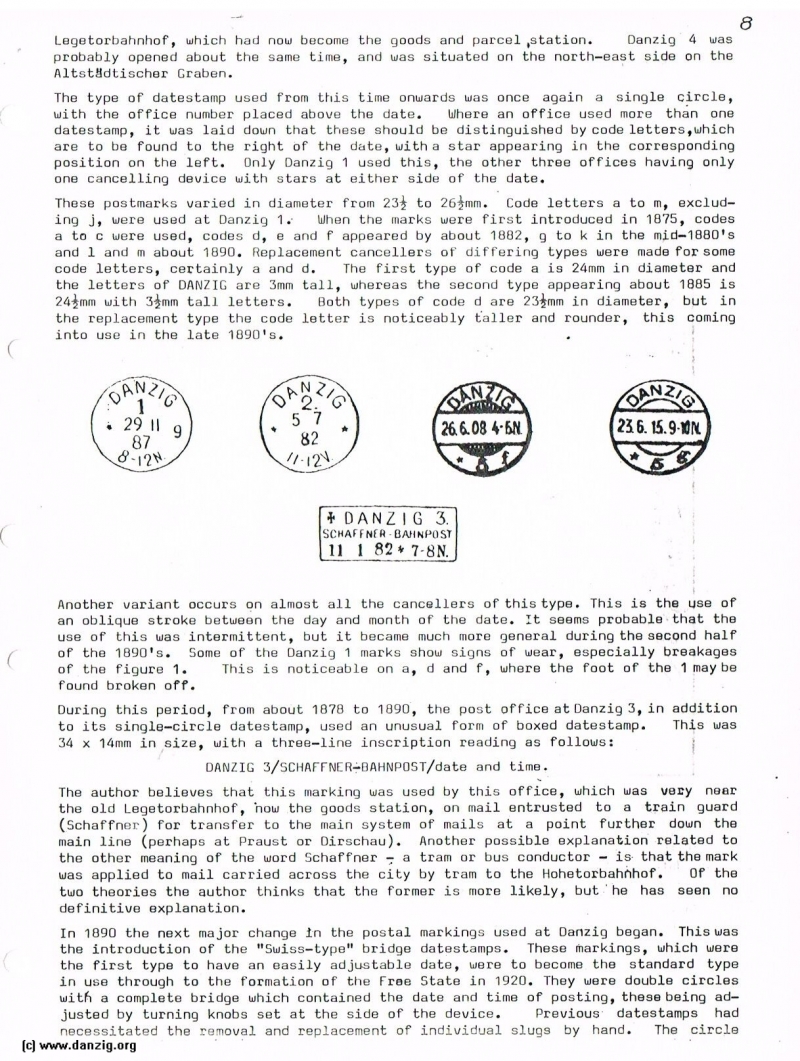
>> DANZIG: Postal History until 1920 - J. L. Whiteside
Logetorhahnhof, which had now become the goods and parcel station. Danzig 4 was probably opened about the same time, and was situated on the north-east side on the Altstädtischer Graben.
The type of date stamp used from this time onwards was once again a single circle, with the office number placed above the date. Where an office used more than one datestamp, it was laid down that these should be distinguished by code letters,which are to be found to the right of the date, with a star appearing in the corresponding position on the left. Only Danzig 1 used this, the other three offices having only one cancelling device with stars at either side of the date.
These postmarks varied in diameter from 23½ to 26½ mm. Code letters a to in, excluding j, were used at Danzig 1. When the marks were first introduced in 1875, codes a to c were used, codes d, e and f appeared by about 1882, g to k in the mid - 1880’s and 1 and m about 1890. Replacement cancellers of differing types were made for some code letters, certainly a and d. The first type of code a is 24 mm in diameter and the letters of DANZIG are 3 mm tall, whereas the second type appearing about 1885 is 24½ mm with 3 mm tall letters. Both types of code d are 23½mm in diameter, but in the replacement type the code letter is noticeably taller and rounder, this coming into use in the late 1890’s
Another variant occurs on almost all the cancellers of this type. This is the use of an oblique stroke between the day and month of the date, It seems probable that the use of this was intermittent, but it became much more general during the second half of the 1890’s. Some of the Danzig 1 marks show signs of wear, especially breakages of the figure 1. This is noticeable on a, d and f, where the foot of the I maybe found broken off.
During this period, from about 1878 to 1890, the post office at Danzig 3, in addition to its single-circle datestamp, used an unusual form of boxed datestamp. This was 34 x 14 mm in size, with a three-line inscription reading as follows:
DANZIG 3 / SCHAFFNER - BAHNPOST / date and time.
The author believes that this marking was used by this office, which was very near the old Legetorbahnhof, now the goods station, on mail entrusted to a train guard (Schaffner) for transfer to the main system of mails at a point further down the main line (perhaps at Praust or Dirschau). Another possible explanation related to the other meaning of the word Schaffner - a tram or bus conductor - is that the mark was applied to mail carried across the city by train to the Hohetorbahnhof. Of the two theories the author thinks that the former is more likely, but he has seen no definitive explanation.
In 1890 the next major change in the postal markings used at Danzig began. This was the introduction of the “Swiss-type” bridge datestamps. These markings, which were the first type to have an easily adjustable date, were to become the standard type in use through to the formation of the Free State in 1920. They were double circles with a complete bridge which contained the date and time of posting, these being adjusted by turning knobs set at the side of the device. Previous datestamps had necessitated the removal and replacement of’ individual slugs by hand. The circle
Danzig Report Nr. 30 - January - February - March - 1981, Page 8.
Hits: 3779
Added: 11/06/2015
Copyright: 2025 Danzig.org

